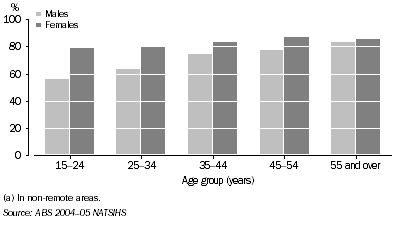PHYSICAL INACTIVITY
Low levels of physical activity are a major risk factor for ill-health and mortality. People who do not engage in sufficient physical activity have a greater risk of cardiovascular disease, colon and breast cancers, Type 2 diabetes and osteoporosis. Being physically active, on the other hand, improves mental and musculoskeletal health and reduces the chances of being overweight, having high blood pressure and/or high blood cholesterol (AIHW 2004). Physical inactivity was the third leading cause of the burden of illness and disease for Indigenous Australians in 2003, accounting for 8% of the total burden and 12% of all deaths (Vos et al 2007).
In 2004-05, three-quarters (75%) of Indigenous people aged 15 years and over who were living in non-remote areas reported being sedentary or exercising at low levels in the two weeks prior to interview, an increase from 68% in 2001. One-quarter (24%) reported exercising at moderate/high levels in 2004-05, compared with 32% in 2001 (see the Glossary for more information).
In 2004-05, rates of physical inactivity increased with age, with two-thirds (67%) of people aged 15-24 years being sedentary/exercising at low levels compared with 85% of those aged 55 years and over. Overall, rates of sedentary/low levels of exercise were higher among Indigenous females than Indigenous males (82% compared with 67%) (graph 8.10).
8.10 SEDENTARY/LOW LEVELS OF EXERCISE, Indigenous persons aged 15 years and over(a)
- 2004-05

One-quarter (25%) of Indigenous people aged 15 years and over who were sedentary or who engaged in low levels of exercise reported fair/poor health, compared with 15% of those who engaged in moderate or high levels of exercise. People who were sedentary/engaged in low levels of exercise were also more likely to be overweight/obese (58% compared with 51%) and to smoke on a daily basis (51% compared with 42%).
Among Indigenous people aged 35 years and over, those who were sedentary/engaged in low levels of exercise were more likely than people who exercised at moderate/high levels to have three or more long-term health conditions (66% compared with 55%). They also reported higher rates of cardiovascular disease (33% compared with 23%) and asthma (18% compared with 13%).
The proportion of females who were sedentary/exercised at low levels was higher than males across all age groups in both the Indigenous and non-Indigenous populations. After adjusting for differences in the age structure between the two populations, Indigenous Australians were more likely than non-Indigenous Australians to be sedentary or to exercise at low levels.
 Print Page
Print Page
 Print All
Print All